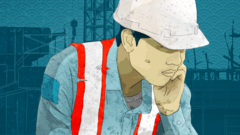Accounts from women detained in Iran's Evin prison reveal severe human rights abuses alongside their resilient spirit as they continue to advocate for change and personal freedom. Despite horrific conditions, they foster community support, create art, and engage in protests against oppression, as they await uncertain futures.
Brave Voices from Inside Iran's Evin Prison: Women's Struggles for Freedom and Rights

Brave Voices from Inside Iran's Evin Prison: Women's Struggles for Freedom and Rights
Women imprisoned in Iran's notorious Evin prison share resilient accounts of survival amidst torturous conditions and their ongoing fight for women's rights and freedoms.
Crouched alone in oppressive solitude, Nasim, a 36-year-old hairdresser and activist, endured immense suffering in a small, windowless cell within Iran's infamous Evin prison. Surrounded by constant threats of torture and execution, she began her harrowing four-month experience in solitary confinement during April 2023. Nasim, along with thousands of others, found herself imprisoned following the "Woman, Life, Freedom" protests ignited by the tragic death of 22-year-old Mahsa Amini, arrested for allegedly violating Iran's hijab laws.
While tales of brutality emerged from former prisoners, rare glimpses into the lives of these women still imprisoned reveal a complex environment. It is a place where brutalities exist alongside quiet acts of defiance and hope. Many women, including Nasim, have transformed suffering into a resolve for change, spending countless hours in interrogations, and witnessing the physical torment of their fellow inmates.
For instance, Rezvaneh, arrested with her husband, encountered threats against his life from interrogators. After enduring solitary confinement, she was placed in a women's wing with about 70 other political prisoners. Unlike Nasim’s solitary cell, these women lived communally in cramped quarters, coping with both physical and emotional hardships. Yet even here, bonds were forged amidst shared adversity.
Within Evin's dark walls, the harsh realities extended to provisions; winters were bitterly cold, summers uncomfortably hot, and food scarce. Nonetheless, the women's resolve was unwavering. They often managed to cook meals from limited supplies while heavily negotiating their needs to staff. Each moment of isolation was punctuated by small, touching moments, like when Rezvaneh discovered her pregnancy after meeting her husband during monitored sessions.
Artistic expression became a form of resistance for some prisoners. Vida, a fellow inmate, painted portraits on bedsheets and the bare prison walls, capturing their experiences and the spirits of those around her, all while compromising with prison authorities who often censored her work. Additionally, medical care remained a critical battle, especially for women like Narges Mohammadi, who faced life-threatening conditions with scant support.
Despite their grim circumstances, the women found ways to combat despair through poetry, song, and camaraderie. Weekly protests against executions grew into an organized resistance, reflecting unwavering hope in transformation, even under incarceration. The women defiantly challenged mandates like headscarf wear and pushed for privacy with bed curtains inside their overcrowded cells.
The imprisonment provided challenges for Nasim and others. After a prolonged wait, Nasim was eventually sentenced to six years in prison, 74 lashes, and 20 years of exile—outcomes that she faced with newfound clarity and resilience. Alongside her in this battle were other women facing severe sentences, underscoring the dangerous climate for Iranian activists.
As protests continued to spread beyond prison walls, expansive calls for justice resonated globally. With over 800 executions in Iran last year marking one of the darkest periods in the nation’s human rights history, the women's voices echoed louder than before, portraying the relentless spirit of resistance against oppressive regimes.
For Rezvaneh, motherhood amidst chaos introduced new challenges, as she navigated her daughter's early days while facing the looming prospect of returning to prison. She is one of the many women whose painful journey illuminates a story of strength, connection, and defiance.
Even in confinement, the struggle and solidarity witnessed inside Evin prison symbolize a broader movement demanding change and women's rights continued. As these brave prisoners endure immense hardship, they insist that their fight against systemic oppression must persist, embodying the message of hope that binds them together through an uncertain future.

















